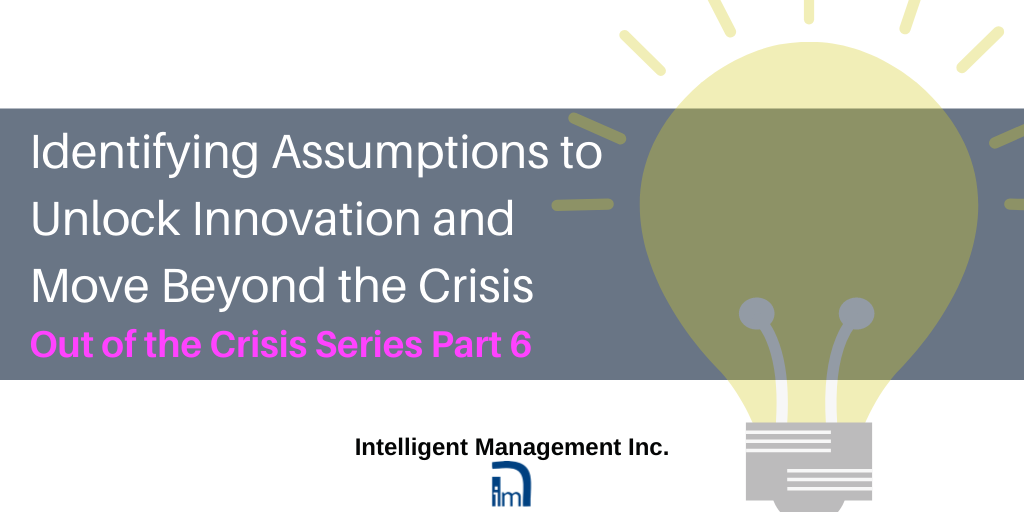
In the previous part of this series, Part 5: Learning to Think Systemically to Make Informed Decisions and Pre-empt a Crisis, we saw how the Conflict Cloud Thinking Process helps us identify a situation of blockage and understand why this blockage exists in the first place. What keeps us stuck is the set of assumptions, or mental models that connect the elements of the conflict together like a connective tissue and keep it alive. We can think of these assumptions in terms of latent thoughts that have never been verbalized but that exist and influence our behavior as an organization. Only by verbalizing these assumptions and “surfacing” them can we challenge them. Identifying and challenging our assumptions is the royal road to moving beyond a situation of blockage, or crisis to unlock innovation and emerge with a breakthrough, systemic solution. In the Theory of Constraints this kind of solution is called an “Injection”.
We framed the current situation of crisis using this Thinking Process and worked on this dilemma with a highly successful client, based on their current reality following the outbreak of Coronavirus. This allowed us to verbalize the conflict more specifically but in a way that is still relevant for the current reality of many organizations living through this crisis. We verbalized the need in B connected with control as “preserve existing customers/relationships” and this leads to wanting to take the conservative action of “subordinate the development of our innovative solutions to the current economic scenario”. The need in C connected with vision becomes “increase value generated by new solutions” and this prompts to wanting to take the expansive action of “leverage the existing economic scenario to boost development of our innovative solutions”. The goal common to the two needs is “Create sustainable development within the new scenario”.
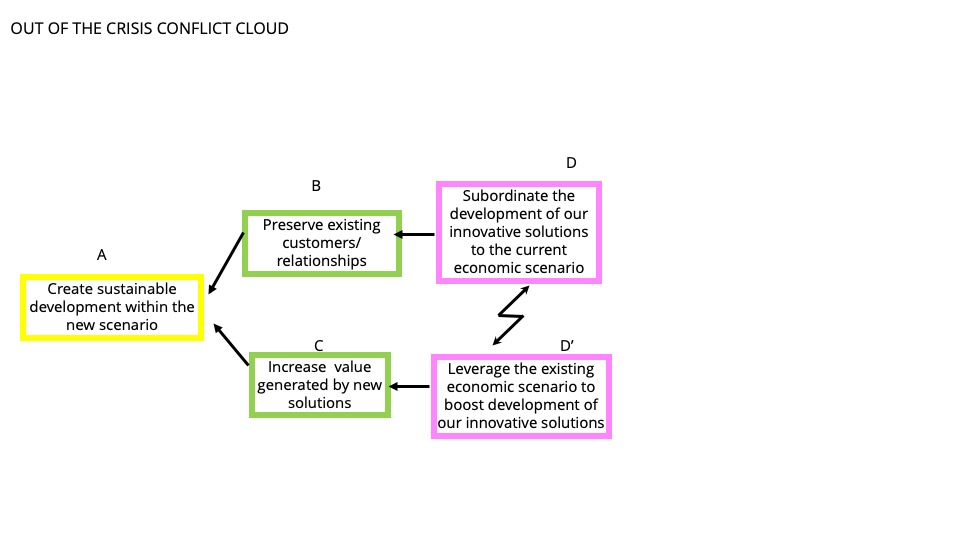
So, what are the thoughts/assumptions/mental models that create this conflict in the first place? How can we verbalize them and then find a way forward? The grey and blue boxes contain the assumptions that connect the elements of the conflict together and keep it in existence.
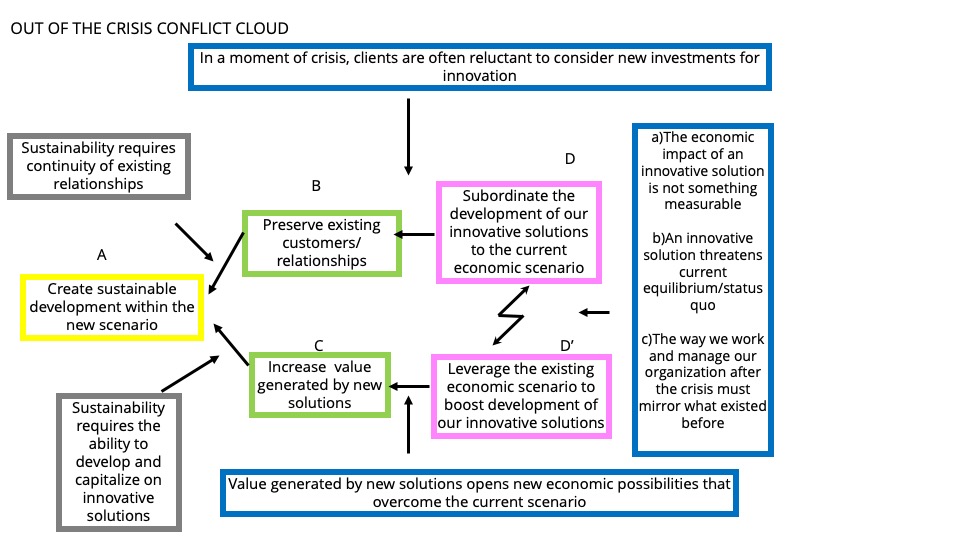
This is how we read the cloud once we have built it:
If our goal (A) is to create sustainable development within the new scenario and sustainability requires continuity of relations, then, (B) we must preserve existing customers/relationships, and if in a moment of crisis, our clients are often reluctant to consider new investments for innovation, then this prompts us to adopt the position (D) Subordinate the development of our innovative solutions to the current economic scenario.
On the other hand,
If our goal (A) is to Create sustainable development within the new scenario, and sustainability requires the ability to develop and capitalize on innovative solutions, then we must (C) increase value generated by new solutions. And if value generated by new solutions opens new economic possibilities that overcome the current scenario then this prompts us to adopt the position (D’) Leverage the existing economic scenario to boost development of our innovative solutions. We find ourselves stuck in this dilemma because we make the assumptions between D and D’: the economic impact of an innovative solution is not something measurable; an innovative solution threatens current equilibrium/status quo; the way we work and manage our organization after the crisis must mirror what existed before.
The conflict, or situation of blockage, will continue to exist unless we challenge the assumptions. The assumptions between the two pink boxes, D and D’ that contain the conflicting positions, are the ones we want to “attack”. In this way we demonstrate to ourselves that what is keeping us stuck is neither true nor valid and we have an alternative: we can choose to change our reality. We start to do this by verbalizing statements (Injections) that invalidate the assumptions but protect the needs in B and C. This is how we create a systemic, sustainable way forward.
We have identified two injections that can help any organization step out of the blockage/paralysis that this conflict depicts. They are:
- We develop and manage the company as an oriented network of projects (constraint-based)
- We accelerate the development and introduction of innovation through execution of constraint-based projects
The conflict cloud allows us to bring the multi-faceted network of formal and informal conversations taking place around the issues at stake into a condensed, workable and visual format. The assumptions, especially the ones between D and D’ represent the set of mental models that allow the conflict to exist. They represent the “cognitive constraint” that limits our ability to overcome such a conflict. By exposing these mental models in a linguistically correct format, we can leverage them to propel the current situation of reality towards one that is more desirable.
Other articles in this ‘Out of the Crisis’ series:
Part 1: A Serious Knowledge Gap Affecting Leaders and Executives
Part 2: What’s Wrong with Organizational Structures?
Part 3: Viral Insights from Managing Variation and Constraints
Part 4: How to Manage Decentralized Work
Part 5: Learning to Think Systemically to Make Informed Decisions and Pre-empt a Crisis
Part 6: Identifying Assumptions to Unlock Innovation and Move Beyond the Crisis
Part 7 A New Economics for Sustainable Prosperity
Contact: intelligentmanagement@sechel.ws
SCHEDULE AN INTRODUCTORY CALL WITH US
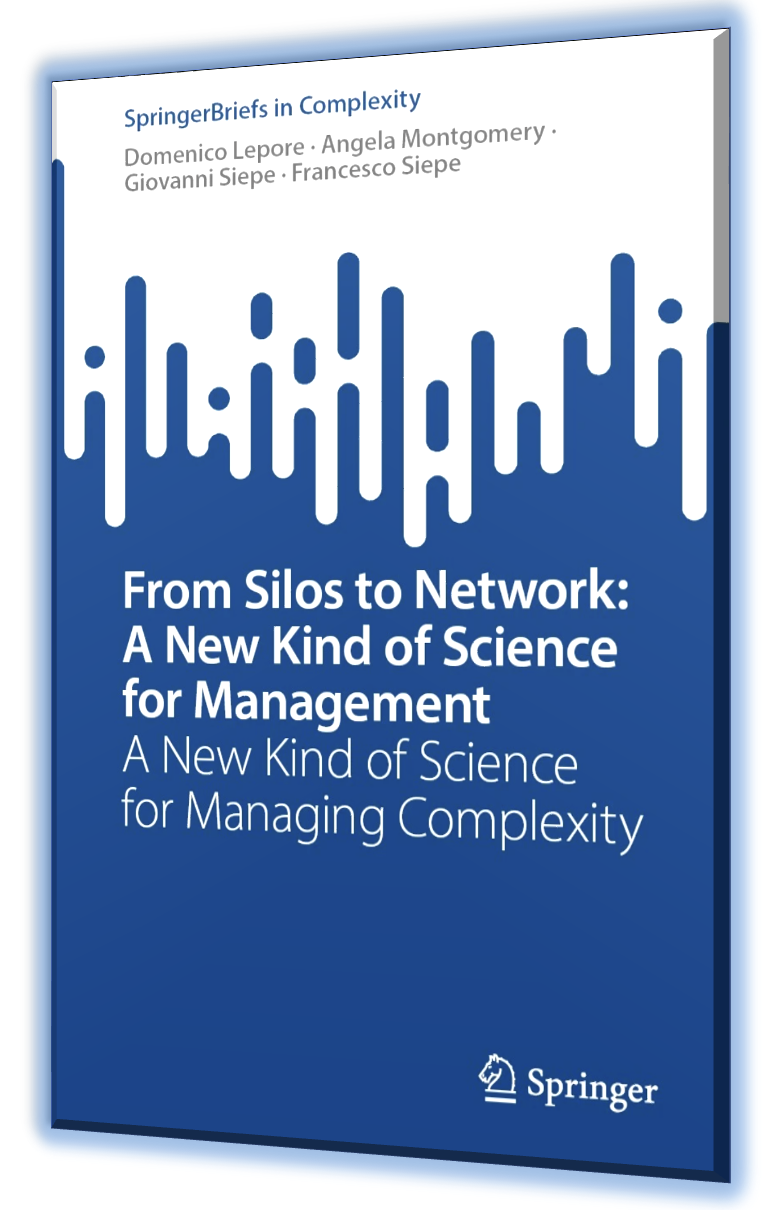
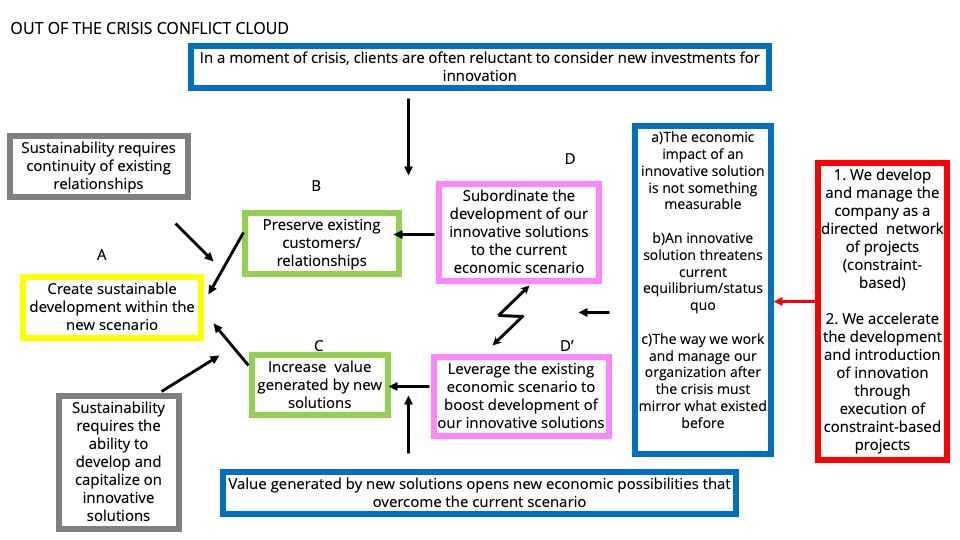





Leave a Reply